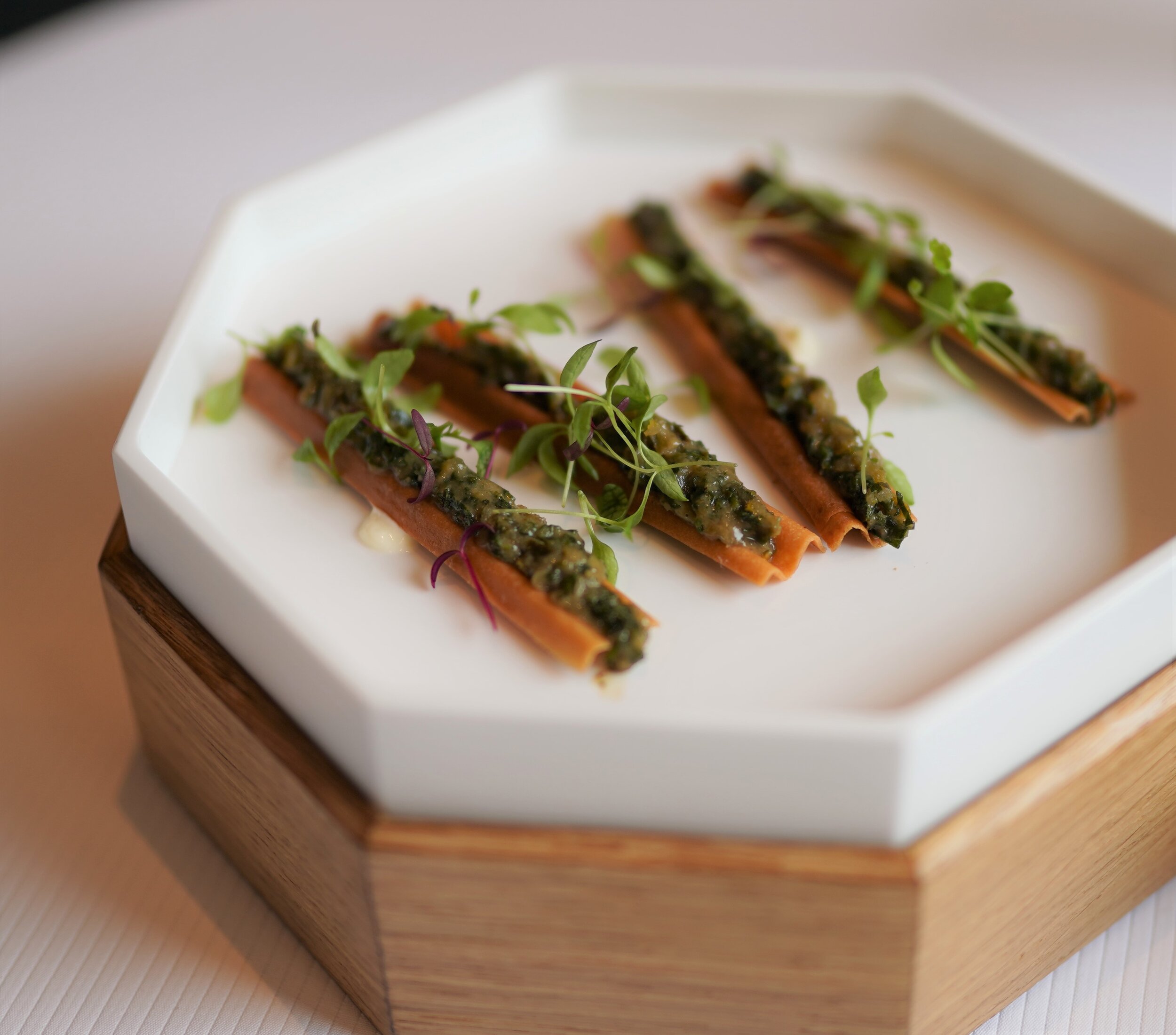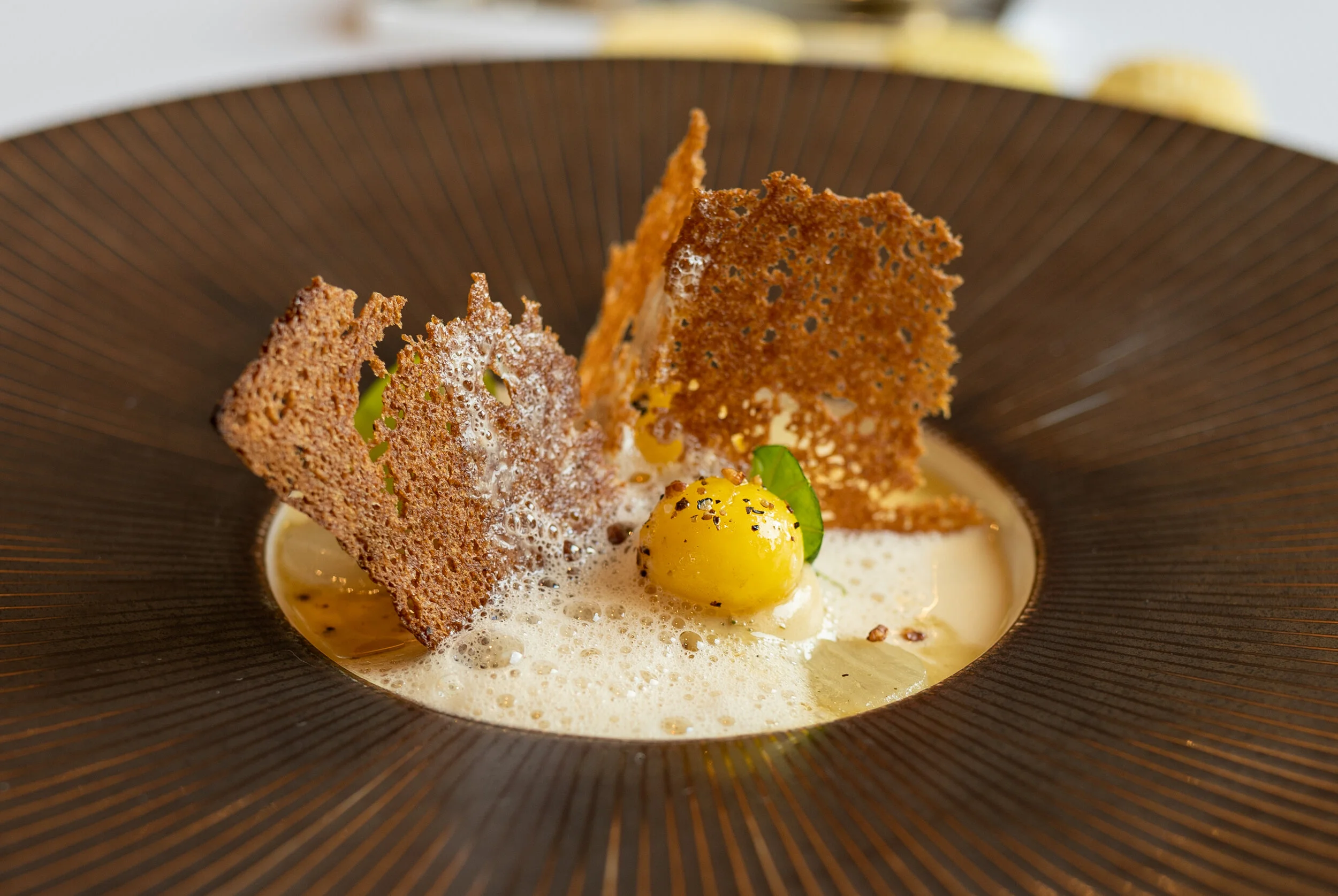L'Assiette Champenoise
L'Assiette Champenoise Review at-a-glance
Awards: 3 Michelin star
+Service was very good, the meal well-paced and in a nice setting with plenty of natural light
-Uneven meal where some dishes were a hit but others lacked balance
Score: 90/100
Verdict: L'Assiette Champenoise was mostly an enjoyable meal. Arnaud Lallement's personality shows in his food - his cooking style focused on sourcing the best products he can find and a biting use of acidity. At my meal, there were dishes that showed what the chef and his philosophy are capable of; a piece of high-quality brill with a rich sauce balanced out by citrus being a highlight. However, there were a few missteps where I found either the product did not live up to the three-star standard or the flavors were out of balance. A precisely cooked Brittany scallop was not nearly as good as a scallop the next day at Le Parc sourced from the same exact region. A lemon tart that was so bracingly acidic I could not finish it. Overall, while enjoyable, there were too many misses and not enough highs to really sync with my expectations of a three star restaurant.
Price I paid: €220 for 6 course menu
Value: 13/20
L'Assiette Champenoise & Arnaud Lallement Background
L’Assiette Champenoise is a luxury hotel in Reims, France which also happens to be the heart of the Champagne wine-growing region. L’Assiette earned its third star in 2014, the first three star in Reims since the restaurant at Les Crayeres hotel. Le Parc was demoted to 2 stars when their chef retired in 2003. Given Le Parc and L’Assiette are less than 5km apart, comparisons between the two restaurants are inevitable with the third star for L’Assiette catching some by surprise that favored the cooking at Le Parc under its current chef, Philippe Mille. For what it’s worth, I visited both L’Assiette Champenoise and Le Parc on my weekend in Reims and tend to agree that Michelin's assessment of the two restaurants is puzzling. I enjoyed the meal more at Le Parc with L’Assiette being somewhat uneven. Not factored into Michelin’s assessment but relevant for diners, I also found the hotel and dining room at Le Parc to be superior than L’Assiette as it was far grander in the way you want when visiting a luxury hotel in Champagne.
The restaurant at L’Assiette Champenoise is run by chef Arnaud Lallement who took over from his father in 2000 and did him proud, earning a first star just a year later, the second in 2005 and the ultimate third in 2014. Besides working under his Dad, Arnaud also trained under many of the last generations of great French chefs including Roger Verge, Michel Guerard and Alain Chapel. Lallement’s cooking style focuses on showcasing the bounty of France but in a lighter style than you would see in a more classic French restaurant. Most pronounced in Lallement’s bag of tricks was the judicious use of acidity in each dish to give them balance.
L'Assiette Champenoise has an extensive set of menus including a 6-course sauver menu for €220 and even longer tasting menu that mixes Lallement classics with current dishes for €315 as well as a shorter weekday lunch menu for a relative bargain of €125. We were visiting during white truffle season where they also offer a 6-course white truffle menu featuring 4 truffle dishes, cheese and dessert for an eye popping €395. Lastly they offered a full a la carte selection with dishes ranging from €85-€135 depending on the ingredients. Overall, this pricing was in line with Le Parc so they have not added much of a surcharge since earning the third star. We went with the 6-course sauver menu which seemed to be the best value as it provided a good introduction to Lallements cooking without the full €315 sticker price of the longest menu.
What we ate at L'Assiette Champenoise
The meal kicked off with a set of amuses and, while I failed to write down the individual components, I remember the one with foie gras being particularly good but the others being mostly forgettable with the texture on the crisps not being as flawless as you’d expect. Somewhat hilariously even though I was eating by myself they did not scale back any of the amuse-bouche portions to keep the presentations on point. They were small bites so I managed to finish them all.
First course was a nicely presented Brittany scallop, beetroot, parsley cream. As you can tell from the photo, the cook on the scallop was exactly what you would want with a nice hard sear on top but a mi cuit center. The scallop itself was of ok quality but fell a bit below the specimen I had at Le Parc the next day and was miles away from the sublime quality of the scallops at KOKS in the Faroe island. The parsley cream sauce was a good choice for the scallop as it was nice and light and paired well with its delicate sweetness. Lastly, accompanying beetroot (which seems to be all over menus these days) showed off even more skill from the kitchen which chose to present the root vegetable in many different variations. Particularly good was the fine dice of the beet which had a bit of champagne vinegar, adding a nice bit of acidity to the entire composition.
The scallop was followed by a gutsy dish from the kitchen, D Vectens Chard, crispy rye, melilot juice, quail egg. I say this was gutsy because the kitchen eschewed any protein and instead decided to focus on the chard with some success. The sauce was particularly good but I am not quite sure this dish was quite the right showcase for it - the rye, which was described as crispy, got a bit soggy by the end and really all I remember from the dish is rye and the sauce with the chard being lost. Bonus points for the technique on the quail egg (sous vide?) which was cooked until just set enough to hold together while keeping a nice running interior.
The favorite course was the seafood course consisting of Brill from Brittany, cabbage ravioli, and a vermouth cream. Brill was an interesting choice of fish as you are more likely to find a nice chunk of Turbot on your French tasting menus. Like Turbot, Brill is a flatfish known for its delicate sweet taste and firm texture. Here it was cooked faultlessly and served with a nice vermouth cream sauce which had just a hint of acid to balance out the whole affair. Like the scallop dish, the fish was accompanied by many variations of cabbage the most interesting of which was an agnoletti stuffed with cabbage and a bit of citrus that was technically well executed and delivered an interesting flavor profile.
It was white truffle season and since I am only living in Europe for two years I could not say no to swapping out the main course for a choice from the truffle menu even though it came with a hefty €85 price tag - Farm reared chicken from Cour D'Armoise, Albufera sauce, white truffle. Sadly this was a bit of a letdown. The chicken itself was nice enough, crispy skin with moist meat and of good quality. The main issue was the accompanying Albufera sauce. Albufera sauce is a variation of the classic French Supreme sauce (which itself is a cream-based deviation of the mother sauce Veloute) that includes a meat glaze to give it a richer flavor. When I have had the sauce in the past it also included foie gras melted into the sauce, giving it a nice deep, luxurious flavor. At L’Assitte the kitchen decided to add parmesan to the sauce, the reason for which was beyond my comprehension. The flavor of the cheese was far too strong and overpowered the taste and aroma of the generously shaved truffles.
The meal picked up again with a very nice cheese cart from Philippe Oliver. While the restaurant opted to source their cheese from Philippe Oliver rather than France’s most famous cheesemonger, Bernard Antony, I could not tell any difference in quality - this was a top-shelf selection all served at pristine temperature and in good condition. Minimal intervention from the kitchen was needed for this course but that did not make the cheese any less enjoyable.
Petit fours were bountiful but did not spark much imagination, including some toasted meringue on sticks, cannelés, mini-crème brûlées, and some chocolates. Much like the amuses, but in an even more exaggerated manner, the portion of the petit fours was not scaled down at all for the fact that I was eating by myself and featured no meringue fewer than 5 of the meringue pops and 9 cannelés.
The main dessert came strangely after the petit fours and consisted of a Lemon tart with Aloe vera. This was a bit of a disaster which was surprising after the solid petit fours. The tart was simple which in itself is not a problem but became an issue as the tart had an overwhelming amount of acid, making your lips pucker and being genuinely unpleasant to eat. Usually, even for the worst course, I will finish it out of principle given the cost but I could not get the job done here. Taste is subjective but at least to my palate I could not understand how this made it out of the kitchen, even a Nordic chef would blush with how much acid was in this dessert. This dish (and the meat course) was a poor end to the meal at L'Assiette Champenoise that quite literally left a bitter taste in your mouth.














